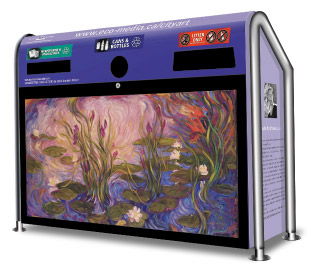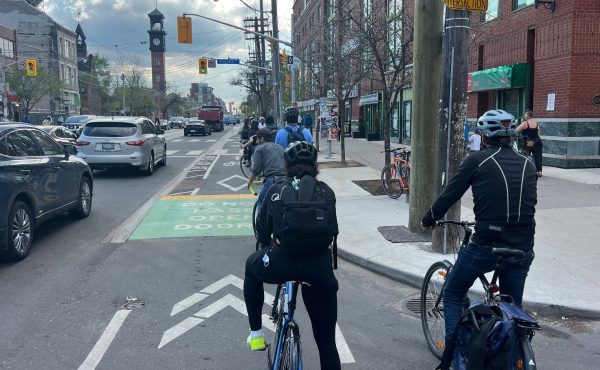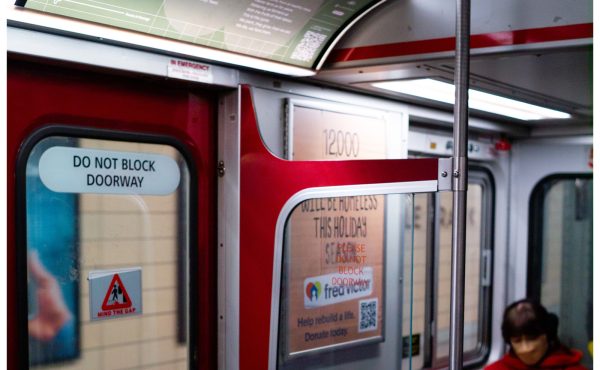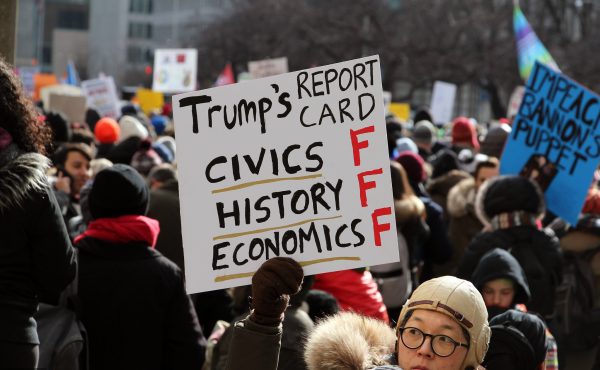
 Ecomedia, the new company that bought out EUCAN and took control of Toronto’s silver box waste bins, introduced an interesting program today that is worth discussing with our readers.
Ecomedia, the new company that bought out EUCAN and took control of Toronto’s silver box waste bins, introduced an interesting program today that is worth discussing with our readers.
The program is called Street Artâ„¢ Sponsorship Program. A few selected bins around the city will display work by local artists. The first artist to be featured is David Arathoon (also check out his website). Ecomedia states they “…launched a Street Art Program to communicate the importance of ART and RECYCLING in Public Spaces. We believe this is one of the cornerstones of civic responsibility. From this point on, until the end of 2009, we will work with our sponsors to showcase a wide variety of Art, our talented Toronto and GTA-based artists, and beautify our urban landscape. As a result, Toronto will be a cleaner and more beautiful city.”
On one side of the bin is a biography of the artist and on the other end is the logo of the sponsor. Craig Marwood, Ecomedia’s president, says each artist is consulted as to which company they wish to be teamed up with.
So here’s my take on this project: On the surface this is a decent start. The public gets to see some art instead of being pressured to buy a product. Why is this significant? When we see something that is not an ad on the street it (sadly) looks out of place and we begin to wonder about it. One of the greatest things about Public Art is how it challenges a person’s regular conceptions (or misconceptions) and sparks some kind of thought-process. An advert for a soft drink or a new condo rarely does this.
Also, one of the many points I’ve tried to make about the perils of ad creep in Toronto is the need for local expression, especially from the arts sector. To some extent, this project addresses my sentiment. This project is also a lot better than the Transit Stories project by OneStop (which asked local photographers to submit photos, without being paid, for display on the platform screens during Contact photo festival) simply because the artist is being compensated for their work.
My concern with the project is simple: I believe small projects like the Street Artâ„¢ Sponsorship Program only further legitimize ad-funded street furniture because the supplier (in this case Ecomedia) is “giving back” to the community. Andy Barrie of CBC’s Metro Morning recently told me he’s trying to convince outdoor video ad companies to display well-known pieces of Canadian art for 1 minute every hour (he says there’s been a few businesses willing to listen to him). I’m interested to hear what Sacing Wire readers have to say on this topic since I haven’t really made up my mind on this issue.




12 comments
Matt, while I agree that it does legitimize ad-funded street furniture, it think over all it is a step in a much better direction. This, of course, is assuming that the artist is paid to do the work at a rate that would match that of the advertising agency who would have traditionally generated the image for the side of the bin.
As an artist, I’ve always avoided doing work for advertisers directly but I realize that the work I do for magazines is getting some or all of their revenue from advertising. Luckily these advertisers don’t get to dictate content (at least at the mags I’ve worked for). They just find something to hitch their wagon to and hand over the money. And a lot of the art I love, comics, tv, movies etc make their money from advertisers in the same way. So I can’t be a pursit when it comes to art not shaking hands with advertisers. I’ve seen episodes of sitcoms that speak to me with more depth than a lot of the ad free gallery exhibitions around town. Good art can transcend the advertising around it.
I’m kind of stoked of the idea of a parton based system. Instead of a company paying an advertising firm bundles of money to calculate the perfect brainwash it would be great if they just said “here, we like your stuff, go for it and we’ll put our names on the back”. No interference or evil schemes, just support for an art, like you get at jazz festivals or wherever else they hang their logos. And the idea that the artist and the sponsor get to choose each other is also top notch. That’s more choice than I get working for a magazine. And there are bound to be some sponsors who artists will genuinely endorse.
I would sign up for this project and I wrote a graphic novel about culture jammers (it was a romantic comedy).
As Marge Simpson would say, Torontonians got the ‘bum’s rush’, when it came to the trash can situation. But with this Street Art Sponsorship Program, we can at least keep our hats in the public art ring, and even encourage other projects. NOW magazine is doing something similar: it’s holding a ‘desgin-a-box challenge’ whereby folks can do just that: http://www.nowtoronto.com/challenge
I know what you mean about being of two minds on this, Matt.
It feels like it’s ok to appreciate this effort to make something good out of this debacle (not that Ecomedia and their brethren see it that way of course), without losing sight of the greater picture that our street furniture situation is a disgrace.
These nouvelle formulation Eucanists are skilled at manipulating Spacers. Did they pitch you this project, likely under press embargo, days or weeks ago, or did you just find out about it today and gave it this much press?
Joe, what does that matter? Movie reviewers typically see films in advance, under embargo, and still give them bad reviews when they open. If Spacing editors got an advance look last week, fine. If they were asked for feedback months ago, it’d be nice to mention that process. If they were paid for any sort of work on this project, it’d be essential to mention that aspect. But really, this is clearly something they’d be posting about whether Ecomedia made it easy or hard for them to get background info.
As for the program itself, it highlights and supports local artists, reduces the amount of advertising in public space, and increases the amount of public art. I’d say it’s pretty hard to argue against without sounding purely ideological.
I agree that artists need sponsors, and introducing art around town is a good thing (like the poetry on the TTC). But I wouldn’t say that it’s purely ideological to make a case for the arts to find other venues for sponsorship – doesn’t that claim itself threaten to chill any meaningful debate on the subject?
In order to find the argument, you need to back up to its roots. Why is the city privatizing garbage bins the first place?
January 2007 article in the Toronto Star about the risks involved in privatizing essential city services.
Sorry, I certainly didn’t mean to chill debate — “hard” isn’t “impossible”, and it’s only my opinion. But privatized garbage bins are, for now, a done deal, so I was focusing on the new Street Art program described here.
Judging by the comments before mine, it seemed like the main reason people were wary of Street Art was because it was an initiative of EcoMedia — i.e. something “good” coming out of the “bad” privatized garbage bins. I can see why people with strong feelings against the bins would feel torn, but if you don’t have those strong feelings I think it would be hard to understand an argument that this “good” program is actually “bad” simply because it’s on an EcoMedia bin.
Of course, if there’s some reason why this isn’t really helpful for local artists, then that changes things. Otherwise, it’s the sort of program I’d hope to see continued — is it too late for something like this to be mandated as part of the new street furniture program?
I think people might be of ‘two minds’ because it’s better than the terrible street furniture Torontonians are used to. The city should have held a (street furniture) design competition for designers and manufactorers to provide unique and beautiful furniture with no ads on them.
Well designed, beautiful cities (of which Toronto is not) get a direct return on their investment through tourism and also include a plethora of other spin off benefits. I know I’m preaching to the converted but I feel Toronto always settles for mediocrity and needs to demand better.
Absent a plausible response from Blackett, and based on this and another post, I’m going to add Ecomedia to my mental list of Spacers’ best corporate friends.
Joe >> Your conspiracy assertions do not deserve much of a response. A PDF was sent out the day before the launch to the media and a phone call was made to Craig Marwood. Happy?
This company has trademarked the terms “Public Space Recycling” and “Street Art”?
There’s information on their site about how to become a sponsor, but nothing about how artists can submit their work for consideration.
The copy on their website is nearly as trite (and floral) as the work of their premiere artist. Are quaint expressionist rural landscapes really appropriate for downtown?